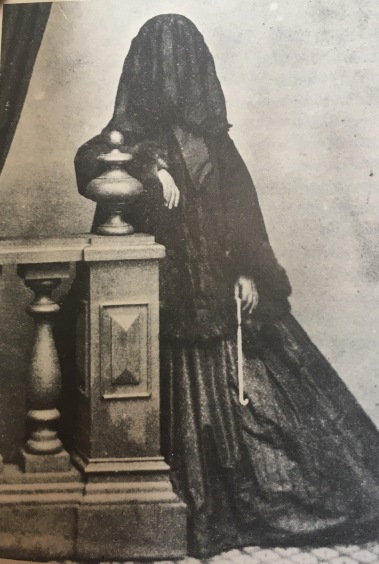British and Irish Women in Black Spirits October 31, 2021
Author: Beach Combing | in : Modern , trackbackIn today’s Boggart and Banshee podcast Chris Woodyard and I talk about the Woman in Black, a largely forgotten and utterly terrifying supernatural figure of American provenance. WiB, as devotees fondly call her, started to be seen in the 1860s in the United States. She would, in the next decades, be spotted in all corners of the country after dark, particularly in provincial towns and reports kept pouring in until the Great War. A tall figure dressed in mourning black with a veil she was not quite ghost, but not quite human. She hugged, kissed, slapped, ran, stuck pins in people, sucked blood, hid in lumber piles, vanished into thin air, appeared out of thin air and generally caused havoc in the dimly lit streets of small town USA. She is often given banshee-like characteristics. Her appearance signalled coming disaster for many communities.
Inspired by Chris’ work in WiBs I went in search of some British and Irish examples of the Woman in Black from the magic sixty years or so when she blew coffin dust into the eyes of our American cousins. From what I can see the British WiBs were rather more physical and of this world than their American sisters. Here is a remarkable 1882 account in which a Cockney WiB is associated with dead babies.
On Wednesday evening the sexton of St. Barnabas, Bromley by Bow, found the dead body of a female child in the churchyard. Death was found to be the result of violence. This makes the fourth infant body found in Bromley within a very short period, and it is stated that in each instance just before they have been discovered a tall woman dressed in black has been seen lurking about the sport. Some children state that just before the Sexton came upon the parcel they saw the ‘Black woman of Bromley’ (which is the name by which the woman is known among the inhabitants) enter the churchyard, stoop as if placing something on the ground, and walk immediately away. It is believed that the woman in question is a baby-farmer, who has an ‘establishment’ somewhere in the district. Efforts have been made to trace her, but, so far, without success. ‘The Woman in Black’, South London Chronicle (1 Jul 1882), 7
The ‘Black woman of Bromley’ sounds to me like an East End bogie, who has been euhemerised by the London constabulary (bless).
Here, instead, is an Irish equivalent, which hints at transvestitism in the famously tolerant nineteenth-century Co Carlow.
During the last two or three weeks a very gall woman, dressed in black, and her face covered with a thick crape veil, has frequently been seen from nightfall till 12 o’clock parading the public roads at the Harrow, Ballyorley, Ballyredmond, Boyra &c., and, when accosted, she does not speak. Some young men one evening lay in wait, and when she was coming up to them they separated, in order to her in; but their intention being obvious to her, she drew a revolver, and told them that the first who dare come near her she would send into eternity. There are various rumours afloat, and it is thought that it is a man dressed in female attire. ‘A Mysterious Woman in Black’, Carlow Post (23 Apr 1870), 2
WiBs in the States were frequently said to be men enjoying the illicit thrill of women’s clothing at night: what better disguise for a man who liked women’s clothes than a full mourning outfit that hid your face and that demanded privacy?
Any other British or Irish WiBs: drbeachcombing AT gmail DOT com
If you are interested in (Pennsylvania) Women in Black Chris Woodyard has provided a small source file with details of her many WiB publications.



